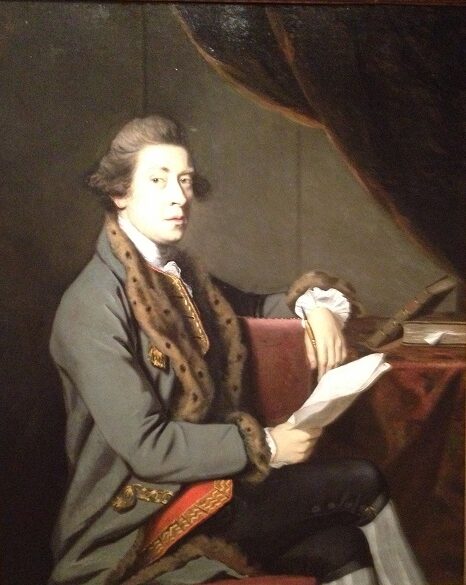
Unknown
English
Portrait of Thomas Gainsborough, 1765 ca.
oil on canvas
49 × 39 3/4 in.
SBMA, Gift of Mrs. H. Chase
1942.22
RESEARCH PAPER
This is a very interesting painting in the SBMA's collection. Although the artist is unknown, the construction and skillful execution of the painting indicates that it was done by either a master or by a master instructing an assistant. As in all Western art, we tend to read the painting from left to right beginning with the book on the table; it has a paper acting as a place holder. The book creates the beginning of a visual line that leads the viewer’s eye towards the main focus, which is the sitter. The strong block of the front arm, and dark shadow behind it bounces our attention back to the center where we can delight in the painter’s virtuosity at painting many different textures: velvet, fur, gold brocade, hair, and skin. The large sideways V-shape created by the curtain and a diagonal line through the letters, hand, and vest also guides the viewer’s gaze into the center of the picture.
The painter used a very limited palette of colors, perhaps only five, mixing them to create all of the colors seen in the painting. Most of the work has been created with quiet colors, known as neutrals, that are created by mixing two complimentary colors together. By contrast, this causes the pure colors of the face and vest to glow and shine. If one looks closely at the layers of textures and colors of paint used to portray aspects of the painting, one sees that up close they are dots, dashes, and drizzles. But from ten feet back they blend into beautiful textures. The bottom left corner, including the legs, is left unfinished.
The sitter is portrayed as a scholar and very rich person He is shown wearing summer ermine which was generally reserved for royalty. It is surmised by some that this portrait is of the very famous painter, Thomas Gainsborough, who was a founding father of the Royal Academy of Painting in London, which was the most important art institution of its time. He painted at a time that this type of portraiture was fashionable.
It is known that Gainsborough employed his nephew, Gainsborough Dupont as an assistant and taught him to paint. Dupont may have done this painting as it is very similar to a self portrait drawn by Thomas that only Dupont would have had access to. Other painters working at this time who were talented enough that they could have been responsible for this painting include Sir Joshua Reynolds, George Romney, Henry Raeborn and Sir Thomas Lawrence. But there is evidence that Gainsborough and Reynolds were not friendly. And Romney, who was said to be friends with Gainsborough, does not note in his diaries of over nine thousand sitters that he had painted Gainsborough. Raeborn, who also embraced this three quarter length style, and Lawrence, who influenced the Curtain and Column School which produced this type of portraits, remain possibilities.
However at the present time, the painter of this fine portrait remains a mystery. We are lucky to have such a beautiful example of eighteenth century English portraiture in our collection, and hopefully with further research the painter will be eventually identified.
Prepared for the Santa Barbara Museum of Art Docent Council by Kim Smith, January 2014.
Bibliography
Gaunt, William, “English Painting”. New York; Thames and Hudson, 1985 print.
Kalinsky, Nicola, “Gainsborough”. London; Phaidon Press Limited, 1995 print.
Sister, Beckett, Wendy, “The Story of Painting”. New York; DK Publishing, 1994 print.
“Techniques of The Great Masters of Art”. London; Quantum Books LTD. 2003 print.
SBMA CURATORIAL LABELS
While the identity of the sitter has never been questioned (the celebrated English portraitist, Thomas Gainsborough), precisely who captured this striking likeness has remained a mystery. Gainsborough, along with Sir Joshua Reynolds and George Romney, was one of the most successful artists of his generation. He exhibited regularly at the Society of Artists and was a founding member of the Royal Academy when it was established in 1768. On the basis of the sitter's well-appointed attire, complete with fur-lined jacket, red vest with elaborate gold-braid trim, and white silk stockings, this portrait must have been done when Gainsborough was at the height of his artistic powers and living in Bath, one of England's most fashionable winter resorts. His identity as a gentleman and intellectual as signaled by the leather-bound volumes, speaks to the social status that Gainsborough had achieved by this point in his career. Only the porte-crayon, a common drawing implement that he grasps lightly with elegant tapered fingers, directly identifies him as an artist.
- Crosscurrents, 2018
Gainsborough, along with Allan Ramsay and Joshua Reynolds, was considered the most successful portraitist of his generation. Like his rivals, he enjoyed the patronage of King George III, as well as a distinguished, London-based clientele. Because he had minimal professional training and was largely self-taught, his art evolved over the course of his career. Unusually, he began as a landscape painter, a subject he continued to treat throughout his lifetime, before turning to portraiture and the figure. Gainsborough shared with the younger artist, Sir Thomas Lawrence, an abiding admiration for earlier artists celebrated for their mastery of expressive color, particularly Anthony van Dyck, Peter Paul Rubens, and Antoine Watteau.
In this portrait, Gainsborough, probably still in his 20s, is shown seated with all of the confidence and self-possession of a well-heeled man of letters. The choice to emphasize the painter's intellectual interests by seating him at a desk, rather than before an easel, emphasizes the cerebral rather than the manual aspect of the artist's profession. While the question of precisely who captured this compelling likeness of Gainsborough remains unanswered, whoever made this portrait possessed a prodigious technical skill, as evident in the sheen of the fabrics.
- Ridley-Tree Gallery, 2013
